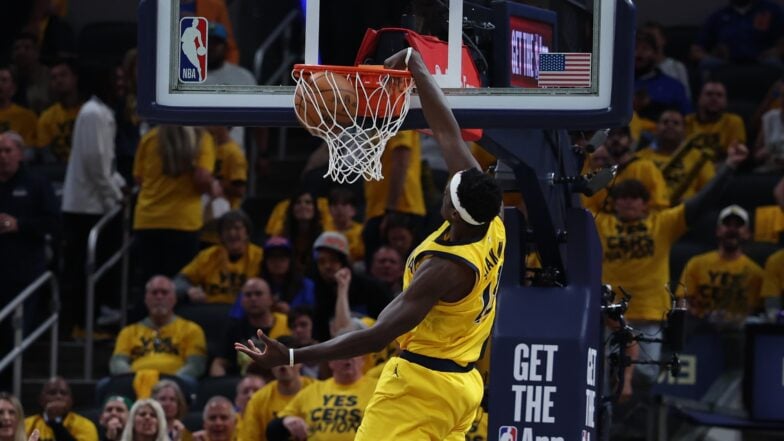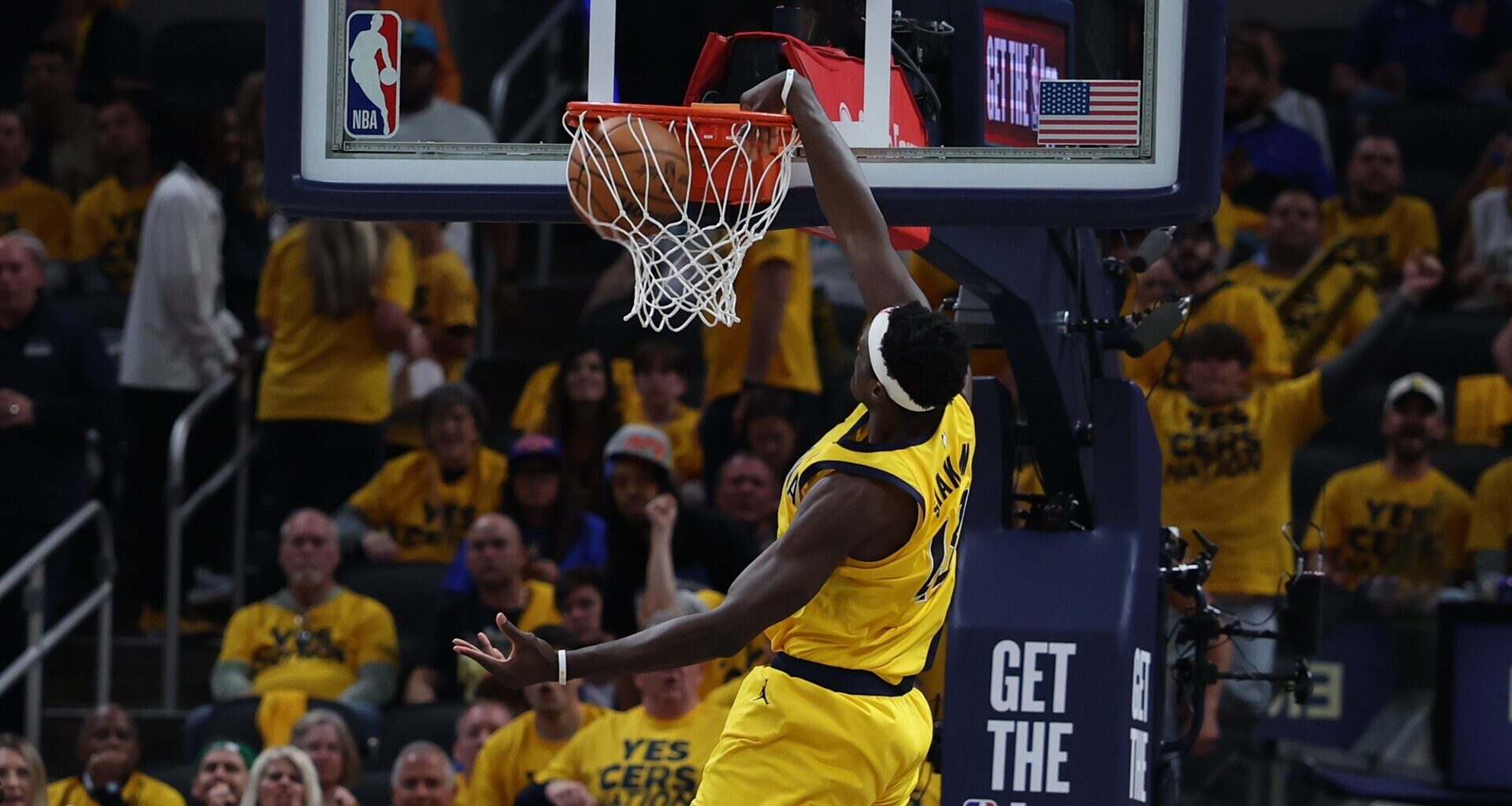
With the exception of their Game 3 collapse, Pascal Siakam and the Pacers have had little trouble scoring on the Knicks.
The Indiana Pacers are one win from their first trip to the NBA Finals in 25 years, and while defense wins championships, offense can get you pretty far, too.
The Pacers’ offense has been the story as they’ve taken a 3-1 lead in the Eastern Conference Finals, with the New York Knicks facing elimination in Thursday’s Game 5 (8 ET, TNT).
Here are some notes, numbers and film as the series moves back to Madison Square Garden.
1. The Knicks can’t get stops
The number: Through four games, the Knicks have scored 118.9 points per 100 possessions, the third-best mark for any team in any series in these playoffs.
… and they’re down 3-1.
The Pacers have scored 121.1 per 100, their best four-game stretch of the playoffs and the worst defensive stretch for the Knicks since the All-Star break. Aside from the second half of Game 3 (42 points on 48 possessions), the Indiana offense has been consistently good.
The Pacers haven’t shot as effectively as they did in the first two rounds, but they’ve taken better care of the ball, gone to the free throw line more and rebounded more of their own misses. And they have, according to Second Spectrum tracking, taken higher quality shots than the Knicks.
The offense hasn’t been as balanced as it was in the first two rounds, and the ball hasn’t moved quite as much. But the Pacers have still averaged 324 passes per 24 minutes of possession compared to the Knicks’ 263.
With the two teams having combined to score 120.0 points per 100 possessions, this is tied for the fifth most efficient series in the 29 years for which we have play-by-play data. One of the four that was more efficient (121.6 per 100) was Knicks-Pacers in last year’s conference semifinals.
2. A contrast of styles
The number: Over the four games, the Pacers have outscored the Knicks by 47 points in transition (106-59), according to Synergy tracking.
The success of the Pacers’ offense starts in transition, where they’ve averaged 26.5 points per game, up from 23.0 through the first two rounds. Live-ball turnovers have been an issue for the Knicks at times, but they have only five more (32) than Indiana (27) over the four games. (They have 23 more dead-ball turnovers.) And they’ve allowed the Pacers to run off misses and makes.
Early in the first quarter of Game 4 on Tuesday, the Pacers inbounded after a Jalen Brunson bucket and Tyrese Haliburton threw a long pass ahead to Pascal Siakam, who had only Karl-Anthony Towns between him and the basket, with other Knicks jogging back…

Bonus number: According to Second Spectrum, Haliburton has averaged 7.8 “pass-ahead” passes per game in the series, 3.3 more than any other player in the conference finals. He led the league with 9.2 per game in the regular season.
It’s not just that the Knicks have allowed the Pacers to run often. It’s also that they haven’t stopped them when they have. Indiana has scored 1.36 points per possession in transition while registering an effective field goal percentage of 71.4% in the first seven seconds of the shot clock, according to Second Spectrum tracking.
Over the four games, the score in the first seven seconds of the shot clock (excluding free throws) is Pacers 100, Knicks 26.
Shooting in the first 7 seconds of the shot clock, Eastern Conference finals
Team
FGM
FGA
FG%
3PM
3PA
3P%
eFG%
%FGA
New York
12
37
32.4%
2
11
18.2%
35.1%
11%
Indiana
44
70
62.9%
12
21
57.1%
71.4%
20%
eFG% = (FGM + (0.5 * 3PM)) / FGA
%FGA = Percentage of total FGA
via Second Spectrum
That 57.1% from 3-point range in the first seven seconds of the shot clock is unsustainable over a larger sample size; the Pacers shot 38.6% from deep in the first seven seconds in the regular season.
But the Knicks may not get a chance to see a larger sample size if they don’t do a better job of contesting the Pacers in transition on Thursday.
The Knicks’ 32.4% shooting in the first seven seconds of the clock is unsustainably bad, but credit the Pacers for playing much better transition defense than their opponent. For the series, the Pacers have averaged 14.1 seconds per possession, while the Knicks have averaged 16.0.
The Knicks have been more successful in the last seven seconds of the shot clock than the Pacers. In fact, Indiana is just 3-for-23 (13%) from 3-point range in the last seven seconds. But it was only in Game 3 where the Knicks forced the Pacers to play late in the clock as often as the Knicks have themselves.
3. Pacers continue to attack Brunson
The number: Brunson has been the screener’s defender on 33.7 ball screens per 100 possessions, up from 26.4 per 100 in the first round and just 16.2 per 100 in the conference semis, according to Second Spectrum.
The Celtics were the most relentless team in the league at attacking weak defenders, and the Pacers have put Brunson in twice as many actions. (Boston preferred attacking Towns.) They’ve had success doing so, scoring 1.20 points per chance (97 on 81) when Brunson has been the screener’s defender on a ball screen.
In Game 4, the Pacers were especially successful (15 points on eight chances) when a Brunson-defended screen was immediately followed by another ball screen, allowing them to attack Brunson and Towns in the same action.
That got Myles Turner a layup when Towns was caught in no-man’s land, even after Mikal Bridges got back in front of Haliburton…

The 29 ball screens that the Pacers set with the man Brunson was guarding in Game 4 were the most he’s defended in any game in his career, according to Second Spectrum. The Pacers might not hit that number again on Thursday, but they might try.
4. Towns is doing damage against Turner
The number: Towns has averaged 25.8 points, his highest average in the nine playoff series he’s played in his career.
Those 25.8 points have come on a true shooting percentage of 66.8%, his second-highest mark in those nine playoff series. Defense remains an issue, but Towns has had a terrific series offensively.
Much of that offense has come against Turner. Towns has shot 19-for-32, including 8-for-11 from 3-point range, when Turner has defended him. There’s some luck in that 8-for-11 shooting from beyond the arc, but Turner has also had trouble defending Towns’ drives…

The Knicks’ change to their starting lineup — Mitchell Robinson in place of Josh Hart — has resulted in more time with Siakam guarding Towns over the past two games. The Pacers haven’t liked that matchup one-on-one, sending a double-team when Towns posted up against Siakam on Tuesday.
Turner has still been the primary defender, and he did have more success defending Towns in Game 4, when Towns was just 1-for-4 against the Pacers’ center. One of those misses was a big Turner block early in the fourth quarter.
With Robinson less effective as a starter than he was coming off the bench, we could see more of the Knicks’ traditional starting lineup in Game 5. That would likely result in more of Towns and Turner matching up, and if the former can continue to score efficiently, the Knicks will have a chance to extend the series.
* * *
John Schuhmann is a senior stats analyst for NBA.com. You can e-mail him here, find his archive here and follow him on X.
The views on this page do not necessarily reflect the views of the NBA, its clubs or Warner Bros. Discovery.

